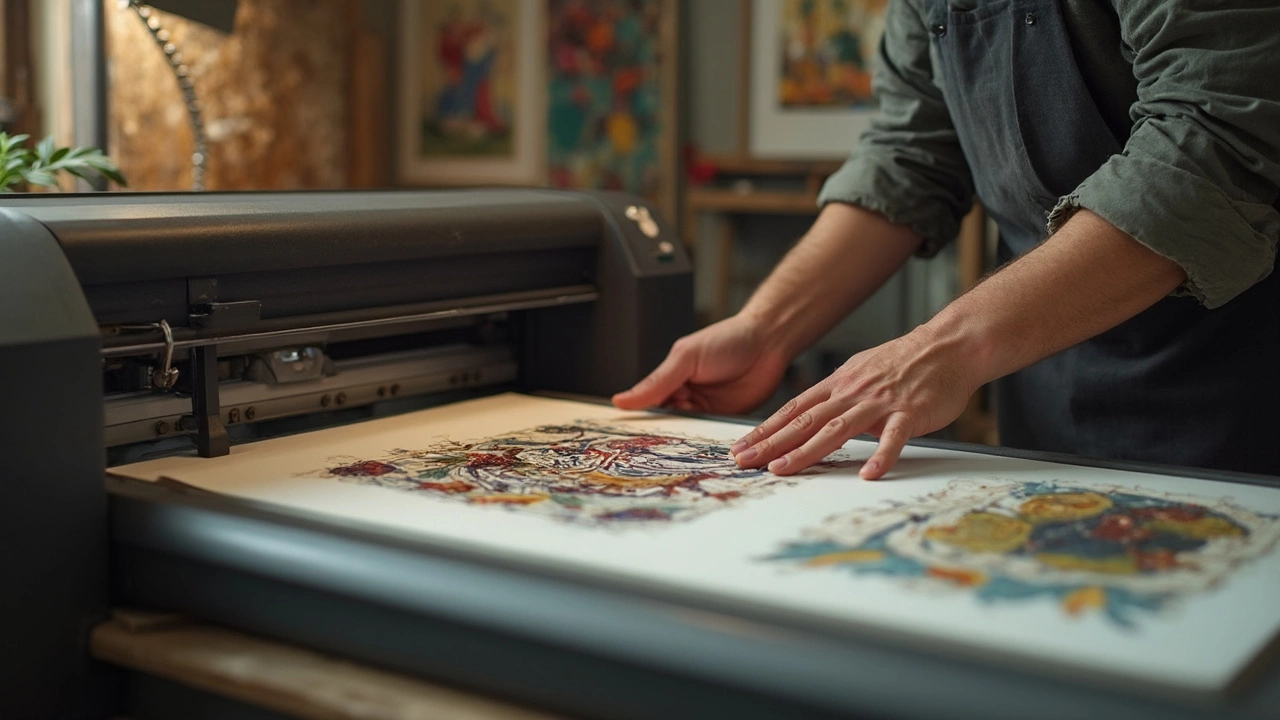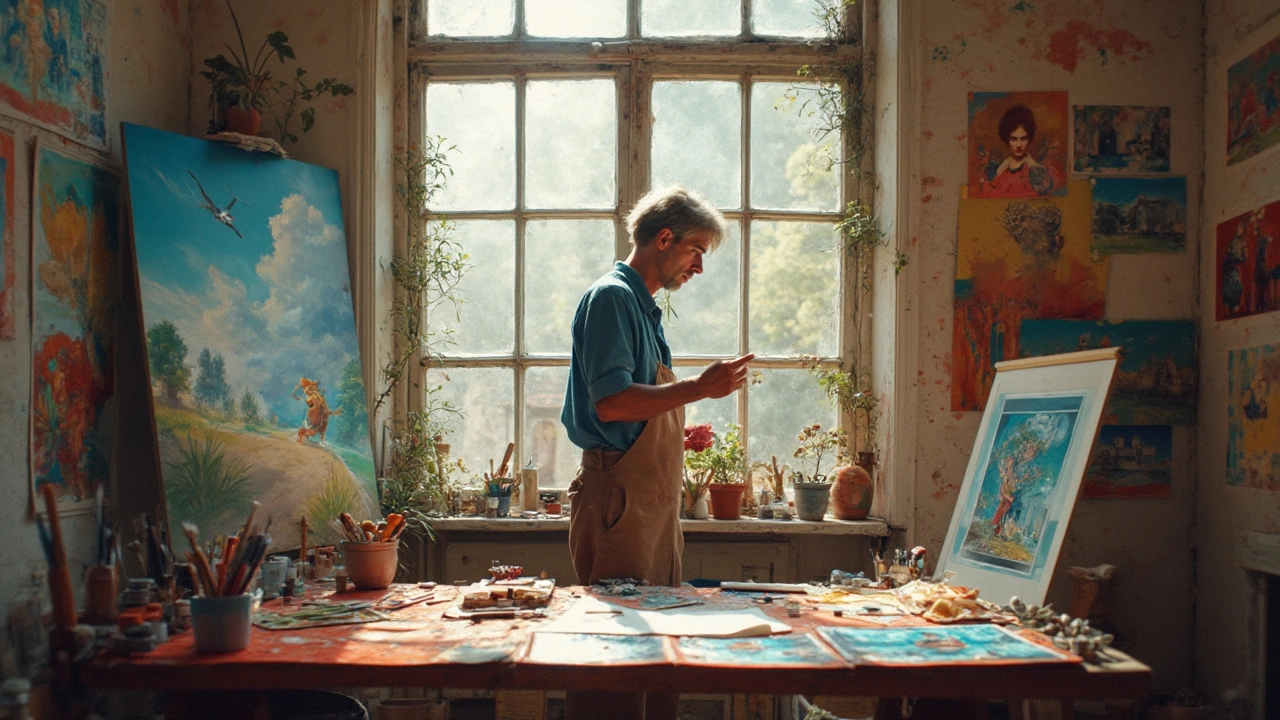Choosing the right printing technique for your art prints can be a game-changer. Each printing method brings something unique to the table, impacting not just the look but also the feel and long-term durability of your artwork. It's kinda like picking the right frame—get it wrong, and the piece just doesn't pop.
Let's kick things off by knowing what's out there. From the modern magic of giclée to the old-school charm of lithography, the choices are plentiful. And each method has its fans, and yes, its critics too. So it's not just about finding a popular pick but discovering what fits your style and needs best.
One of the top methods for artists these days is giclée. People love it because it’s top-notch for capturing those vivid colors and sharp details. It’s like the superhero of printing techniques for anyone who creates digitally or wants to reproduce their work without losing that artistic flair. But, spoiler alert: it's not always the cheapest option.
- Understanding Printing Methods
- Giclée Printing: The Artist’s Favorite
- Screen Printing for Bold Art
- Lithography: Classic and Timeless
- Cost and Quality Considerations
- Tips for Selecting the Right Printing Method
Understanding Printing Methods
Alright, let’s get into the nitty-gritty of art prints, because knowing your printing methods can really make or break your artwork. Each technique has its pros and cons, largely influenced by the kind of art you’re working with and what you're aiming to achieve. It's kinda like choosing between sneakers and dress shoes—each has its perfect moment.
First off, we have giclée printing, a sweet favorite among modern artists. Why? Because it uses high-quality inkjet printers to create prints that look and feel almost identical to original art. The details are so sharp you could practically cut yourself. Giclée is particularly great for digital art or photographs, capturing all the amazing details with fantastic color depth.
“With giclée, you’re not just preserving the art; you’re giving it a new life,” says renowned artist Jake Parker.
Next up is screen printing, which is a classic method—and a bit messy, honestly, but worth it for that bold, vibrant output. It involves pressing ink through a screen stencil onto the paper, perfect for big, eye-catching designs. It’s not as detailed as giclée, but it’s unbeatable for its durability and vibrant colors.
And let’s not forget lithography. It’s the granddad of printing techniques, using greasy ink and water on limestone or metal surfaces. This technique is known for its timeless quality, often used for larger production runs of art prints. It’s a bit more of a hands-on process but offers a unique texture and character.
For those looking at price tags and trying to weigh quality against budget, remember this:
| Printing Method | Typical Cost | Best For |
|---|---|---|
| Giclée | $$$ | Detailed, vibrant art |
| Screen Printing | $$ | Bold, graphic designs |
| Lithography | $$ | Classic, high-volume runs |
Understanding these methods lets you make an informed choice, thinking about both the art you create and how it’ll be displayed. Whether it's giclée's finesse, screen printing's boldness, or lithography's charm, each method offers something to elevate your art prints game.
Giclée Printing: The Artist’s Favorite
When it comes to reproducing artwork with precision and vibrancy, giclée printing often steals the show. This method, born in the digital age, offers incredible detail, making it a top choice for those who demand quality.
Giclée prints are well-loved because they use high-resolution inkjet technology. The inks? They're not your run-of-the-mill stuff. We're talking archival quality, which means your prints won't just look great today—they'll last for decades without the colors fading away.
This printing method excels in capturing both the subtle shades and the boldest hues, which is why it's a go-to for those selling art prints online or in galleries. Its flexibility is also a huge perk. Artists can offer prints in almost any size without worrying about losing detail or depth.
"Giclée printing allows artists to reproduce their work with incredible accuracy and longevity. It's like giving your art another life," says Jane Doe, a renowned printmaker.
Although giclée is fantastic, it’s not always the cheapest route. This got me thinking: what's the cost comparison like? Generally, giclée stands on the higher end of the price spectrum when compared to traditional methods. But for many artists, the splurge is worth it for the quality it delivers.
| Printing Method | Durability (Years) | Cost Range ($ per print) |
|---|---|---|
| Giclée | 60-100+ | 40-100 |
| Screen Printing | 20-40 | 10-50 |
This table gives a bit of a sneak peek into how giclée stacks up against other techniques in terms of durability and cost. It's pricey but tends to last a lifetime. So if you're shooting for art prints that look amazing and won't age fast, giclée is seriously hard to beat.
Screen Printing for Bold Art
If you're all about making a statement with your art prints, screen printing might just be your jam. This method is super popular for giving artwork a bold, vibrant look, especially when you're messing around with larger areas of solid color. Think about those eye-catching concert posters or funky t-shirt designs—they're often brought to life with screen printing.
So, how does this magic happen? It’s a bit like stenciling. A mesh screen is used to transfer ink onto your paper, with a separate screen for each color. That means you’re mixing inks manually and layering them up, which gives you control and depth. Of course, the more colors you use, the more screens you’re dealing with.
A well-known American print shop once said, "Screen printing allows artists to physically connect with their creations, giving them a tangible, hands-on way to leave their unique mark on every print."
This technique is awesome for mass-producing prints, making it a go-to for artists looking to sell their work. Plus, it’s quite adaptable—whether your canvas is paper, fabric, or even wood, screen printing adds that punch you're gunning for.
- Pro: High durability. Screen prints don’t just fade away quickly; they’re built to last.
- Con: It requires more setup and can be a bit tedious if you're doing a one-off piece.
And here's a fun fact about screen printing: it's been around since ancient China but really hit its stride with Andy Warhol’s iconic pop art in the 1960s. Warhol’s use of screen printing helped elevate it as a legitimate form of art printing.
| Screen Printing Pros | Screen Printing Cons |
|---|---|
| Vivid colors | Time-consuming for multiple colors |
| Durable prints | Not ideal for intricate details |
| Great for bulk production | Initial setup can be costly |
For artists craving that vivid, tactile feel, screen printing is where it's at. Just remember that upfront, you've got the setup to deal with, but the results? Totally worth it.

Lithography: Classic and Timeless
When you hear about lithography, think of it as the vintage wine of printing methods—classy, timeless, and with a flair that modern techniques sometimes just can't match. This method has been around since the late 1700s, invented by Alois Senefelder, and it’s still appreciated by art buffs who love its unique touch.
So how does it work? Lithography is all about the magic of oil and water. Artists draw directly on a flat stone or metal plate with an oil-based substance. After treating the surface with a chemical mix, it’s ready to print. Ink sticks to the greasy parts while the wet areas repel it, transferring the image onto paper. This whole setup allows artists to produce as many copies as they need, which is perfect for art prints!
Why do artists love it? Well, lithography lets you blend colors smoothly and capture intricate details and textures—something that’s tough to nail with other methods. It’s especially great for artworks that need to maintain subtleties and tonal variations.
But don’t just take my word for it. Famous artists like Toulouse-Lautrec and Picasso used lithography to create some of their most iconic works. They loved the method for its precision and flexibility, allowing them to experiment with bold and soft elements alike.
Now, onto the less glamorous side—cost. Lithography isn't the cheapest. The process can be quite labor-intensive, especially when compared to digital methods like giclée printing. Plus, you might need specialized materials or expert help, which can add up.
- If you’re thinking about trying lithography, consider whether your artwork’s style truly benefits from it. It’s particularly brilliant for achieving classic looks.
- Since it’s a bit on the pricier side, weighing your budget is key. Make sure the costs align with your financial goals.
- Work with professionals who know their stuff. This isn’t something you want to gamble on if you’re new to it!
This method might not be the go-to for every artist these days, but its charm and effectiveness in producing timeless pieces cannot be overlooked. Whether you're a history enthusiast or someone aiming to add a traditional touch to your art prints, lithography can be a rewarding choice. Just be sure it matches the vibe you're going for with your work!
Cost and Quality Considerations
When diving into the world of art prints, understanding cost and quality can be a real game of balances. Let's break that down a bit. The key here isn't just to look at price tags but to weigh them against the quality you're getting. After all, nobody wants to invest in prints that look snazzy today but fade away like a summer tan.
Take, for instance, giclée printing. It’s adored for its stunning color precision and longer lifespan, thanks to those fancy archival inks. But, heads up! It can be a bit on the pricey side. We're talking anywhere from $15 to $40 per print, depending on paper choice and size.
Meanwhile, if you're vibing with bold and vibrant prints, screen printing might be your jam. It’s fantastic for producing rich, solid blocks of color, and it’s often used for posters and limited editions. Costs here can range from $10 to $30 per print, influenced by factors like the number of layers (more layers, more cash).
Then there's the old-school cool of lithography. It gives prints a unique texture that some folks really dig. It can be stunningly beautiful but isn't the cheapest option either. Expect to shell out $25 to $50 per print, partly because it's more labor-intensive.
It's super important to consider what you're willing to invest in your art prints. Are you gunning for top-tier quality or keeping an eye on your wallet? Sometimes, paying a bit more upfront saves you money in the long haul with less wear and tear.
Here's a quick look at some average cost ranges for each method:
| Method | Cost Per Print |
|---|---|
| Giclée Printing | $15 - $40 |
| Screen Printing | $10 - $30 |
| Lithography | $25 - $50 |
Don’t forget, quality can also affect how your audience perceives your work. The aim is to leave them in awe—and the right printing method can totally help you nail that.
Tips for Selecting the Right Printing Method
Getting the best out of your art prints means choosing a printing method that matches your vision and budget. Here's a breakdown of some handy tips to make an informed decision.
First off, think about the type of artwork you're working with. If you're into detailed and vibrant digital art, giclée printing is your go-to. It captures colors and details better than most techniques, which is why it's a big hit among digital artists. Just remember, quality comes at a price.
Is your work more about bold colors and graphic designs? Give screen printing a shot. It's known for creating rich, deep colors and is perfect for posters, apparel, or anything that needs to maintain vibrancy over large areas.
Then there's lithography, which is worth considering if your heart is set on something traditional. While it can be labor-intensive and maybe not as budget-friendly, it can deliver that classic look and feel, which can be perfect for certain types of artwork.
It's always smart to weigh the cost against quality. While giclée is a bit more expensive, its fade resistance and high-detail capacity can mean fewer reprints in the long run. But if you're testing different styles or doing bulk prints, screen printing might be more cost-effective.
Finally, don't skip out on doing a test print version when possible. Use it as a chance to see, feel, and critique how different methods handle your art. This way, you can tweak things before committing to a full batch, saving you time and cash down the line.
| Printing Method | Best For | Considerations |
|---|---|---|
| Giclée Printing | High-detail digital art | Higher cost, exceptional color accuracy |
| Screen Printing | Bold, solid colors | Good for bulk, less detail in gradations |
| Lithography | Traditional art look | Medium-high labor, classic touch |

